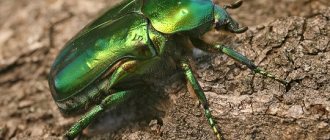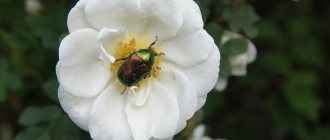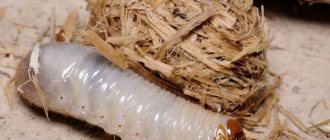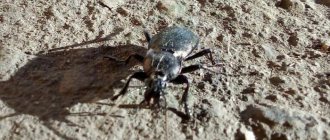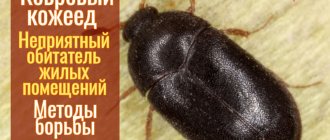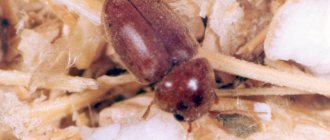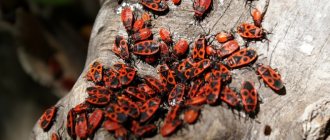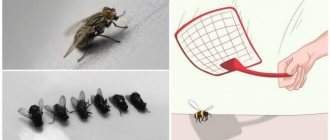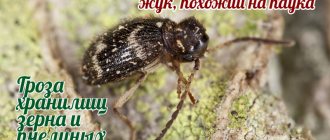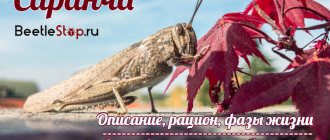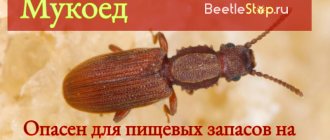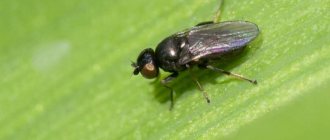A small object rapidly flies through the air, hits an obstacle and falls onto the road. A metallic sheen is visible in the dust. What is this? Bullet? Upon closer inspection, it turns out that it is a beetle. But they don't fly that fast! In the sun it shines and shimmers, as if made of bronze. It seems that scientists have managed to invent a miniature flying robot spy.
Don’t be surprised, this is not a fantastic machine; nature can create things that are not so outlandish. Here is an ordinary bronze, which can be found in almost all corners of the globe.
Description of the pest
The stinking/spotted bronze beetle, or stinking/spotted deer (Oxythyrea funesta/cinctella) is a beetle belonging to the family Scarabaeidae. This pest is widespread, but the largest number of its populations is observed in the zone of steppes and forest-steppes. Flower meadows, especially those with calcareous soils, are also attractive to this beetle. Among the favorite delicacies of the stinking bronze beetle, flowers of fruit trees (mainly apple, pear, peach, cherry), field crops (rapeseed, sweet clover), as well as ornamental plants (rose suffers more than others) occupy a place of honor.
If everything is clear with the rather prosaic name of bronze, which indicates a spotted color, then there is currently no unanimous opinion regarding the emergence of another (unsightly) name. Some researchers believe that it is due to the fact that, after holding the beetle in your hands for some time, you can feel the unpleasant odor emanating from the pest. Others see the name as a mistranslation of the Latin word “funestus,” which means “mourning, tragic,” rather than “smelly, fetid.”
The stinking bronze is notable for its shiny black coloration with white spots on the sides, back and elytra. The size of the body, which is usually covered with short light hairs, is 8-13 mm. It should be noted that some older individuals have no hairs, as they wear off over time. The peculiarity of this beetle is that during flight it does not raise its elytra, but spreads its wings through a special hole.
Females of the stinking bronze fly lay their eggs in fertile soil, with particular preference given to lands with a large amount of humus. After about 2 weeks, larvae emerge from the eggs (reach a size of 30 mm), which feed on dead plant roots, but they do not cause much harm. Flight occurs in May-July. During the day, adult individuals feed on the pollen of flowers, their leaves and petals, sometimes completely eating the stamens and pistils, thereby often causing very significant damage to plants. The plant not only loses its decorative effect, but also stops developing. Fruit crops may subsequently fail to produce a harvest at all. In autumn, with the onset of cold weather, the beetle hides in the soil and remains there for the winter, and next spring it comes out again to feed on flowers.
Development from egg to adult
For laying eggs, the bronze moth chooses loose substances: compost heaps, rotten wood and stumps, anthills. Soon they hatch into larvae, which eventually reach a length of up to
5 cm. For the future population, it is important that the temperature regime is optimal; with a strong deviation in one direction or the other, either only females or only males will emerge from the cocoons.
The larvae have a thick white body and six short, weak legs. They feed on rotten parts of plants. The digested remains perfectly fertilize the soil, and voracious creatures serve as a good source of natural black soil. The larvae are perfectly adapted to underground life, but become helpless once on the surface. Their weak legs are unable to move their heavy body, and they have to move on their backs, sharply contracting their strong muscles.
To transform into a pupa, the larva collects pieces of leaves and rotten wood, combines them with sticky secretions of its body and builds a cocoon in which transformation into an adult will take place. The adult insect overwinters in the ground and comes out into the air in the spring.
The entire cycle from laying eggs to the emergence of the bronchi on the surface is 2–3 years.
Pest control measures
Since the stinking bronze bug develops, spends the night and winters in the earthen cover, it is advisable to treat the soil in the garden with hexachlorane to a depth of 5 cm. In the daytime, a mechanical method of pest control should also be used. A litter or hard surface is spread under the tree, then the plant is shaken, after which the fallen beetles are collected and immediately destroyed. It should be borne in mind that in hot weather the beetles are very mobile and can quickly take off, so before shaking the tree, it should be well sprayed with water. You can also collect beetles from low plants by hand.
The fight against the stinking bronze beetle is complicated by the fact that this beetle is capable of covering quite long distances in flight, so it is often elusive. If there are a large number of beetles, during flowering you can spray the plants with a solution of the Calypso preparation.
Features of bronzes
In the classifier of insects, the bronze is located in the order Coleoptera in the family Lamelidae. Its scientific name, Cetonia, is translated from ancient Greek as metal beetle. In fact, these insects are black, but if you examine their integument under a microscope, you can see their complex structure. Rays of light are refracted in microscopic irregularities, creating an unforgettable play of shades and tints.
Beetles try not to waste energy - they can sit for a long time on one flower, where they have “both a table and a home.” In cool, damp weather they hardly move at all , waiting for a hot sunny day to fly to another place. Bronze birds fly quickly, but sometimes they crash into obstacles and fall on their backs. In this position, the insect is most vulnerable: since it is difficult for it to roll over, this process takes a lot of time.
Almost all species of beetles fly slowly, as the raised elytra create strong air resistance.
Nature gave bronze beetles an unexpected gift: they have special cutouts through which the beetle releases its thin wings and takes flight. At this time, the rigid elytra lie on the back and do not interfere with rapid movement.
Marble
An analogue of the golden bronze with a green shell decorated with white markings. The marbled fish often has a greenish tint to its shell. The body size is slightly larger: up to 27 mm.
Distributed throughout Eurasia, except for the mountain forests of the Caucasus and Crimea. Prefers lowland forests. Settles on old trees. The species is numerous, but insects are found alone. These beetles are active from June to August in the European part of Russia and from mid-May to mid-August in Ukraine.
The life cycle in warm regions takes 1 year, in northern regions – 2 years. Females lay eggs in old stumps of some tree species.
What does a carpet beetle larva look like?
The main distinguishing feature of the larvae of almost all skin beetles is the presence of a large number of long, stiff hairs on the body. In some species, this “fur” is so thick that it hides the body itself.
For example, this is what a mullein beetle larva looks like:
To an inexperienced eye, it may seem that the insect does not even have the characteristic worm-like body shape, but looks more like a tuft of fur.
In fact, the larvae of skin beetles have the same body shape as the larvae of other beetles. It’s just that this body is hidden behind thick hairs that form a very unique outfit.
In larvae of skin beetles of different species, the density and length of hairs on the body vary significantly. Thus, in carpet beetle larvae, the body itself is clearly visible and it is clear that they are to some extent similar to caterpillars:
And in the house leather beetle, the larvae are so shaggy that the body is not visible, and the hairs on the back of it form a kind of “tail”, the length of which is commensurate with the length of the body:
On a note
It is incorrect to call the larvae of skin beetles either caterpillars or worms. Caterpillars in science are called butterfly larvae; they have very characteristic features of the body structure that the larvae of skin beetles do not have. For example, butterfly larvae have several pairs of false legs on the back of the body, with which they can grasp branches or other supports. The larvae of beetles (including leather beetles) do not have false legs. The larvae of skin beetles have even less in common with worms - the worms themselves belong to a completely different class and even type of living creatures, and the similarities between them and the larvae of skin beetles end with the elongated shape of the body.
By the way, the hairs on the body of the larvae become thicker and longer as the larva itself grows and develops. Immediately after hatching from the egg, the larva is small, thin and almost naked - there are hairs on its body, but they are sparse and thin.
This photo, for example, shows what newly hatched carpet beetle larvae look like:
As the larva grows and feeds, its “fur” becomes thicker, longer, and in some species completely hides the insect’s body underneath, as if under a fur coat. This is what the last instar larva of the skin beetle looks like:
Be that as it may, it is the thick hairs on the body of the skin beetle larva that are the main identifying feature that allows you to distinguish it from any other insects living in the apartment. Due to such hairs, the appearance of the larva is so unique that once you see and identify it, you will no longer be able to confuse it with any other pest.
How and with what can skin beetles be removed?
Skin beetle larvae are destroyed by almost any insecticide, including those intended for household use. This allows you to fight them almost everywhere, wherever they are: drugs can be injected into the cracks behind the baseboards, they can be spilled on thick bedding and carpets, in the depths of which the smallest larvae can huddle between the fibers, they can be used to treat any furniture elements.
As a rule, after thoroughly treating with a good insecticidal agent all the places where the larvae can hide, not a single one of them remains alive.
For such destruction, products based on insecticides of different groups are suitable:
- Pyrethroids – most of the drugs in the Raid, Raptor, Combat lines, as well as Delta-Zone, Lambda-Zone, Medilis-Ziper, Get Express, and others.
- Organophosphorus compounds - Executioner, Karbofos, Medilis-Malathion, Get Total, and others.
- Silicon dioxide in various forms (including kieselguhr) - Hector, Ecokiller, Eco-Dust.
The more places in the room are sprayed with a solution of one, or even better, several of these products, the greater the likelihood that all skin beetles here will be destroyed.
Ideally, you should spray your apartment not with a hand sprayer, but with a cold fog generator, the solution from which itself is drawn into the narrowest crevices with air. But only professional disinfectors have such generators, and it is possible to treat a room in this way only by calling a special service.
Treatment of an apartment using a cold fog generator
According to our statistics, after proper treatment of the premises, skin beetles die here completely in 100% of cases. At least, in our practice, there were no situations when, after disinfestation of skin beetles, we had to do a second treatment in order to finish off the surviving individuals. In all treatments, all larvae and beetles die the first time.
By the way, skin beetle larvae have a weak point, which to some extent makes the task of destroying them easier.
Coloring
The color of bronzes is very diverse. These beetles are not always beautifully colored. Even within the same species and habitat, the color of bronzes can vary greatly.
On a note!
Sometimes the coloring is formed by special highlights that completely cover the main background. The color can be with or without a metallic sheen.
Bronze beetle
With a metallic sheen, that is, shiny, oily-shiny and matte-shiny:
- green with various shades is the most common in the group;
- blue;
- copper red;
- purple;
- purple;
- bronze;
- black with a metallic sheen.
Beetles without a metallic sheen may have the following colors:
- black;
- brown;
- brown;
- red in different shades;
- green;
- yellow;
- white with an olive or gray tint.
On a note!
All members of the family have a characteristic feature: light spots, shaped like the edges of scales.
The spots may be:
- yellowish;
- clay-yellow;
- white;
- pink.
They are located on the elytra, pronotum, underside of the abdomen and upper part of the hind legs. The spots can be of different sizes and shapes. Sometimes these markings merge, covering most of the beetle's body. Most often this happens on the elytra.
General characteristics of beetles
The body is short. The rear line is almost straight. The transitions from the back to the sides are rounded. The head is small, directed down and forward. This family is called lamellar because of the special structure of the antennae, which, if necessary, the insect unfolds into a fan of plates.
Interesting!
The flight speed of bronze beetles is significantly higher than that of other flying beetles.
This success in bronzebacks is due to the special structure of the elytra: there are small cutouts on the sides between the abdomen and the rigid plate. Through them, insects release translucent brown wings. The elytra remain folded and do not slow down the bronco. Other beetles are forced to open their elytra, which stick out upward and to the sides during flight and greatly interfere with flight.
